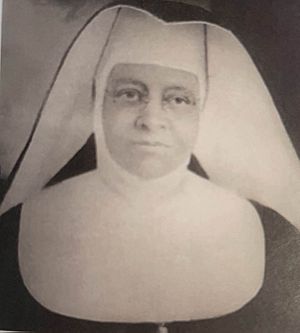Mary Theodore Williams facts for kids
Quick facts for kids Mary Theodore Williams |
|
|---|---|
| Mother Superior | |
 |
|
| Church | Catholic Church |
| Personal details | |
| Birth name | Elizabeth Barbara Williams |
| Born | February 11, 1868 Baton Rouge, Louisiana |
| Died | July 14, 1931 (aged 63) New York City |
| Nationality | American |
| Occupation | Teacher |
Mother Mary Theodore Williams (born Elizabeth Barbara Williams; February 11, 1868 – July 14, 1931) was an American Black Catholic nun. She is famous for starting a new group of Catholic sisters called the Franciscan Handmaids of the Most Pure Heart of Mary in 1916. This group helped many African American children and families.
Contents
Early Life and Calling
Growing Up in Louisiana
Elizabeth Barbara Williams was born on February 11, 1868, in Baton Rouge, Louisiana. She grew up in a time when life was very different for African Americans.
She received her education from two groups of Catholic sisters. First, she learned from the "Ladies of the Sacred Heart." Then, she studied with the Sisters of the Holy Family. This second group was one of the oldest communities of African American nuns in the United States.
Becoming a Sister
When she was 19, Elizabeth joined the Sisters of Saint Francis Convent in Convent, Louisiana. This was her first step into religious life. However, this order was later closed down in 1912.
After that, she joined another group, the Oblate Sisters of Providence in Baltimore. There, she became a novice and was given the name Sister Mary Theodore. A novice is someone who is preparing to become a full member of a religious community. Later, she left this community to think more about her special calling from God.
Founding a New Community
A Need for Black Sisters
In 1915, Sister Mary Theodore was working at Trinity College in Washington, D.C. She heard about a big need in Savannah, Georgia. A priest named Father Ignatius Lissner wanted to start a new group of Black Catholic sisters.
At that time, there was a proposed law in Georgia. It aimed to stop white teachers from teaching Black children in public schools. This law worried Father Lissner because it could close schools that helped Black children. He tried to get help from other African American sister groups, but they could not send anyone. So, he decided to create a new one.
The Birth of the Handmaids
Sister Mary Theodore felt called to help Father Lissner. On October 15, 1916, she officially became part of the new order. She took on the name Mother Mary Theodore. This was the beginning of the Franciscan Handmaids of the Most Pure Heart of Mary.
The proposed law in Georgia never passed. However, the sisters still faced many challenges there. They taught children during the day. To earn more money, they also ran a laundry business at night. On weekends, they would ask for donations along the waterfront.
Moving to New York
In 1913, Archbishop Hayes of New York invited the sisters to run St. Benedict’s Nursery in Harlem. This was a place that cared for children. Because of this invitation and the difficulties in Georgia, the sisters decided to move.
In 1923, the main house of their community moved to Harlem in northern Manhattan, New York City. This is where their main house remains today.
Growth and Recognition
By 1925, Mother Theodore's community had grown to sixteen members. Women from the West Indies also joined the group. In 1929, Mother Theodore's hard work paid off. Her community officially became part of the larger Franciscan family. They were recognized as members of the Third Order Regular. This is how they became known as the Franciscan Handmaids of the Most Pure Heart of Mary.
Mother Mary Theodore Williams passed away in New York on July 14, 1931. Her legacy lives on through the work of the sisters she founded.
Facing Challenges Together
Mother Mary Theodore Williams was not the only one in her family to face challenges because of their race. Her cousin, John Plantevigne, became a priest with the Josephites. This group of priests was formed to serve African Americans.
Father Plantevigne also faced difficulties. In 1909, he was not allowed to preach in New Orleans. The Archbishop at the time, James Blenk, said he was worried about how white people in the city might react. This shows the racial barriers that existed for African Americans, even for those serving in the Church.

